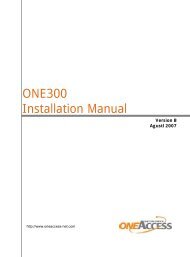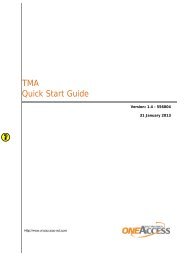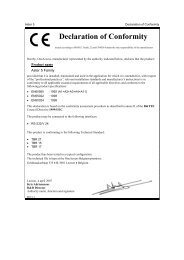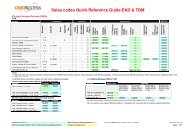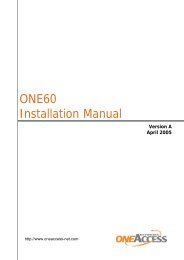1134 & 1135 Web User Guide rev2.0 - OneAccess extranet
1134 & 1135 Web User Guide rev2.0 - OneAccess extranet
1134 & 1135 Web User Guide rev2.0 - OneAccess extranet
You also want an ePaper? Increase the reach of your titles
YUMPU automatically turns print PDFs into web optimized ePapers that Google loves.
TELINDUS <strong>1134</strong>/<strong>1135</strong> <strong>Web</strong> Interface <strong>User</strong>’s <strong>Guide</strong>6. ADSL Router termsWhat is a firewall?A firewall is protection between the Internet and your local network. It acts similarly to the firewallin your car, protecting the interior of the car from the engine. Your car's firewall has very smallopening that allow desired connections from the engine into the cabin (gas pedal connection,etc), but if something happens to your engine, you are protected.The firewall in the ADSL Router is very similar. Only the desired connections that you allow arepassed through the firewall. These connections are normally originating from the local network;such as web browsing, checking your email, downloading a file, and playing a game. However, insome cases, you can allow incoming connections so that you can run programs like a web server.What is NAT?NAT stands for Network Address Translation. Another name for it is Connection Sharing. Whatdoes this mean? Your ISP provides you with a single network address for you to access theInternet through. However, you may have several machines on your local network that want toaccess the Internet at the same time. The ADSL Router provides NAT functionality that convertsyour local network addresses to the single network address provided by your ISP. It keeps trackof all these connections and makes sure that the correct information gets to the correct localmachine.Occasionally, there are certain programs that don't work well through NAT. Some games, andsome specialty applications have a bit of trouble. The ADSL Router contains special functionalityto handle the vast majority of these troublesome programs and games. NAT does causeproblems when you want to run a SERVER though. When running a server, please see the DMZsection below.What is a DMZ?DMZ really stands for Demilitarized Zone. It is a way of separating out part of your local networkso that is more open to the Internet. Suppose that you want to run a web-server, or a gameserver. Normal servers like these are blocked from working by the NAT functionality. The solutionis to "isolate" the single local computer into a DMZ. This makes the single computer look like it isdirectly on the Internet, and others can access this machine.Your machine isn't really directly connected to the Internet, and it really has an internal localnetwork address. When you provide the servers network address to others, you must provide theaddress of the ADSL Router. The ADSL Router "fakes" the connection to your machine.You should use the DMZ when you want to run a server that others will access from the Internet.Internal programs and servers (like print servers, etc) should NOT be connected to the DMZWhat is a Gateway?The Internet is so large that a single network cannot handle all of the traffic and still deliver areasonable level of service. To overcome this limitation, the network is broken down into smallersegments or subnets that can deliver good performance for the stations attached to that segment.This segmentation solves the problem of supporting a large number of stations, but introducesthe problem of getting traffic from one subnet to another.To accomplish this, devices called routers or gateways are placed between segments. If amachine wishes to contact another device on the same segment, it transmits to that stationdirectly using a simple discovery technique. If the target station does not exist on the samesegment as the source station, then the source actually has no idea how to get to the target.One of the configuration parameters transmitted to each network device is its default gateway.This address is configured by the network administrators and it informs each personal computeror other network device where to send data if the target station does not reside on the samesubnet as the source. If your machine can reach all stations on the same subnet (usually abuilding or a sector within a building), but cannot communicate outside of this area, it is usuallybecause of an incorrectly configured default gateway.Version 1.0 Page 54/54 October 2004




